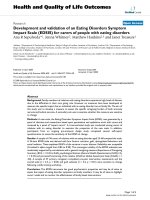6785 eating disorders
Bạn đang xem bản rút gọn của tài liệu. Xem và tải ngay bản đầy đủ của tài liệu tại đây (139.54 KB, 1 trang )
Read the following text written by Jacquie Mccarnan and answer the
questions on the right.
Usually when you read an article about anorexia and
bulimia it's pretty depressing. There are stats about how many
people have the disease, how many people don't report it, how
many new cases there are, how many girls (and boys too) worry
about their weight, how much power the media has on body
image...whew!
This article is going to be a bit different.
The image above covers most of the prevalent numbers in
the eating disorder realm. Not too many people are completely in
the dark about Eating Disorders (ED) anymore. In the last 20
years the amount of information and awareness of ED has
improved to the point where almost everyone, in the western
world, has heard of Anorexia and Bulimia (and their lesser
recognized cousins, Binge Eating and Excessive Exercise).
Most often articles on ED focus on these numbers. The
ones in the image. The devastating reach of the disease.
We feel that there are far too few articles, movies and Facebook
pages that focus on recovery and optimism.
The reality of an ED is that people who have one are
society’s most ardent followers. They see what western
civilization views as "perfect" and they strive to fulfil that
requirement. Sometimes they are so successful that they are
actually killing themselves to meet the demand for perfection.
The film, No Numbers - Identity Beyond Measure,
acknowledges these people in a way that no other film has. It
examines the reasons why so many young people find themselves
struggling with an eating disorder but it goes far beyond that to
examine the roads to recovery.
As much as we would love this film to help people to learn
to love themselves the way they are, we are targeting those
people that are suffering now. Some are doing it alone, with no
support and no treatment. Some likely believe that they are
successful at meeting society’s expectations.
We want them to see that they do not have to live up to
some randomly, media-driven model of perfection. We want to
show them how "perfect" comes in a million packages and that
finding their way starts with that first step, the step towards
self-acceptance.
February is Eating Disorder Awareness Month all over
North America and the UK. Throughout the month our goal is to
have the film No Numbers - Identity Beyond Measure screened in
as many places as possible.
(adapted)
A) Say who or what the underlined
words in the text refer to.
B) Match the equivalents.
1. depressing
2. stats
3. prevalent
4. support
5. consciousness
6. less significanta. lesser
b. disappointing
c. help
d. statistics
e. common
f. awareness
C) Explain the meaning of:
1. Not too many people are completely
in the dark about Eating Disorders.
2. […] and their lesser recognized
cousins, Binge Eating and Excessive
Exercise.
D) Questions about the text.
1. According to the author of the text
there aren’t resources that show how
to recover and how to be optimistic.
Quote from the text a sentence that
illustrates this statement.
2. What’s the first step to recovery?
3. Which film does the author of this
text suggest us to see?
4. What is the film about?
E) Topics for discussion.
1. How critical are you of your body?
2. How far would you go to change
how you look?
3. What are the dangers of going on
eating binges and then vomiting?
4. What would you do if a friend of
yours had an eating disorder?









